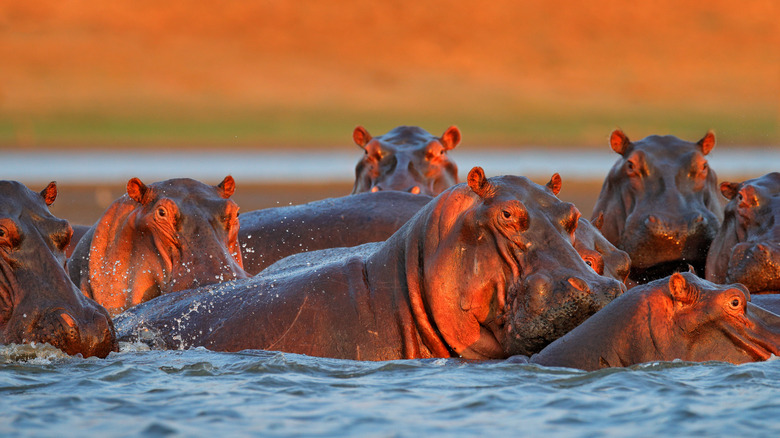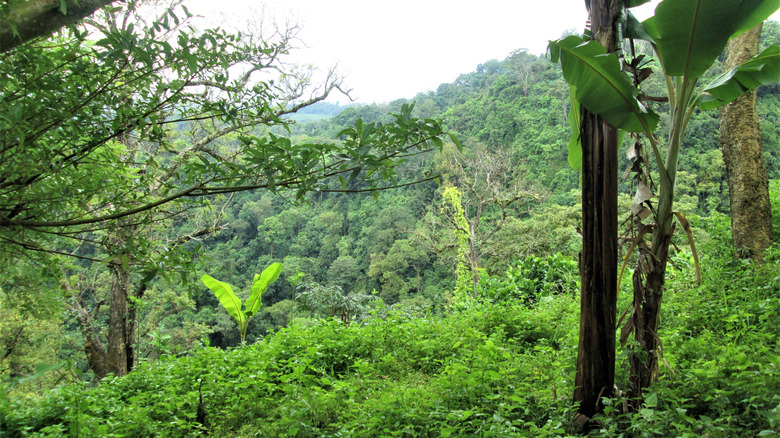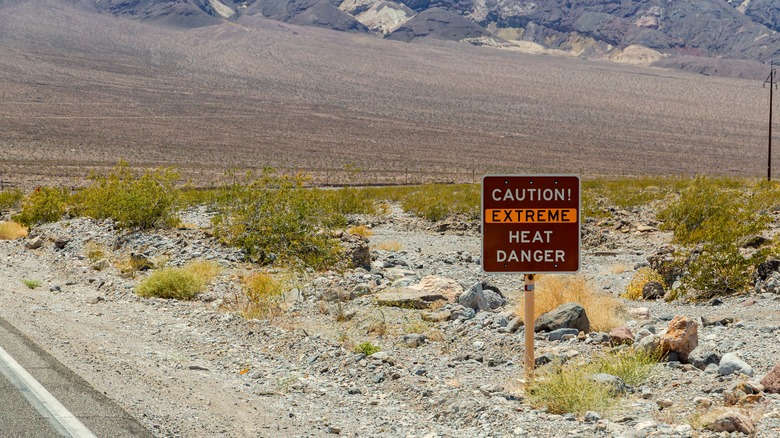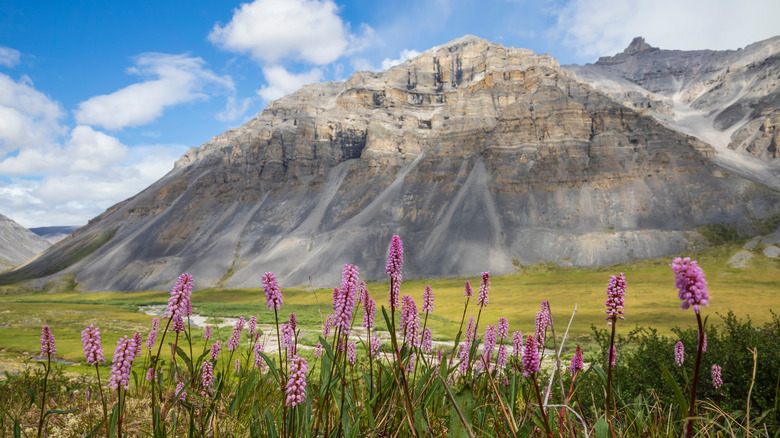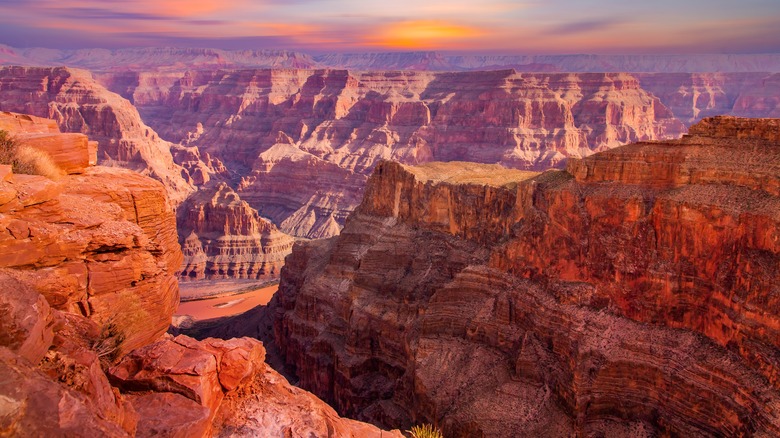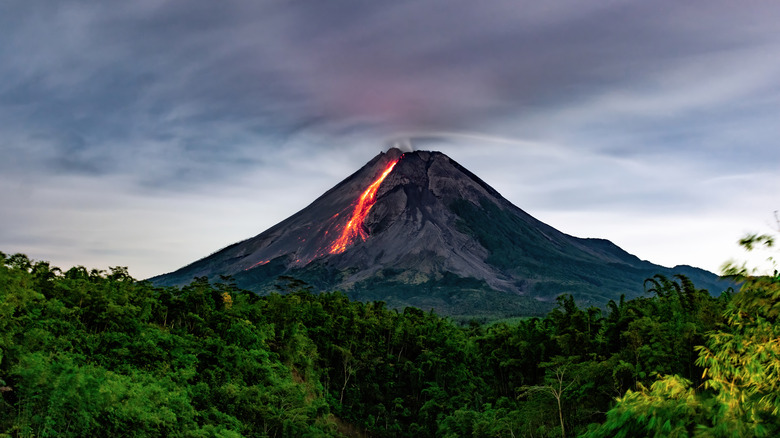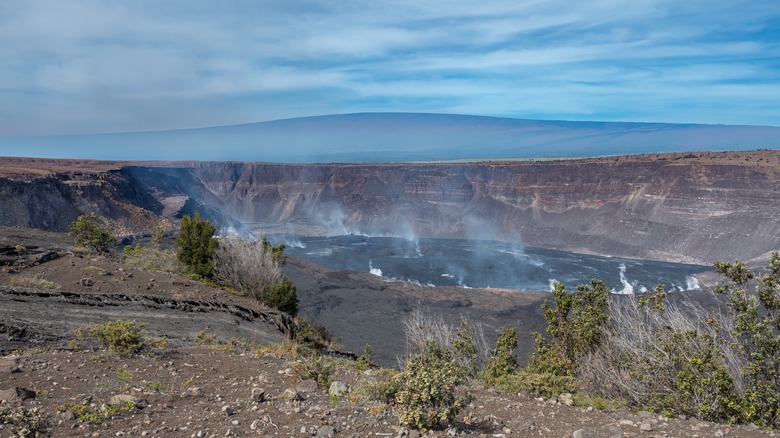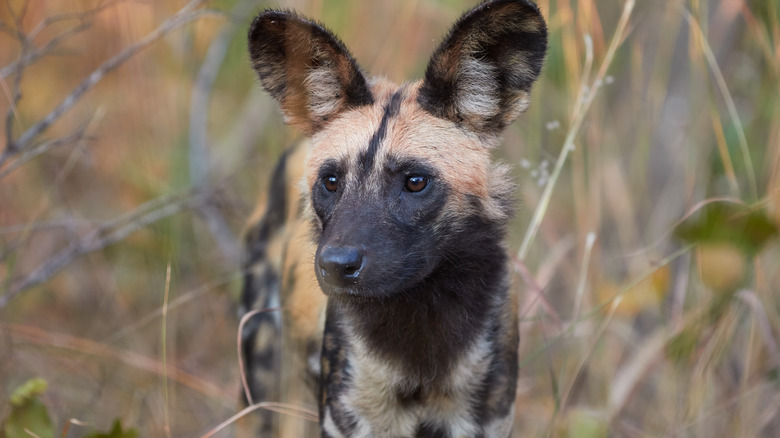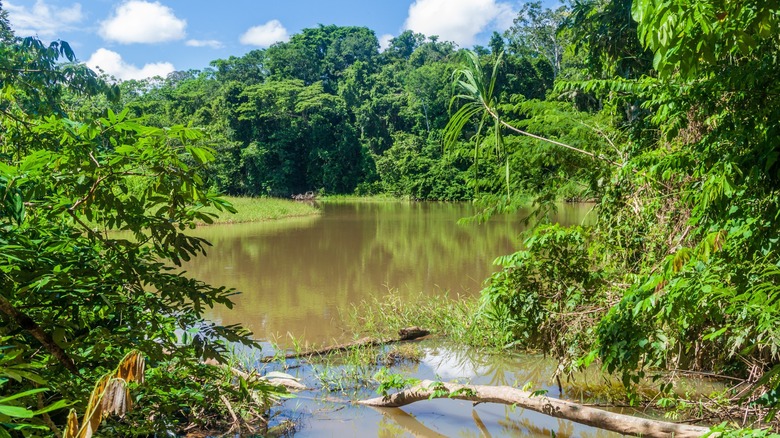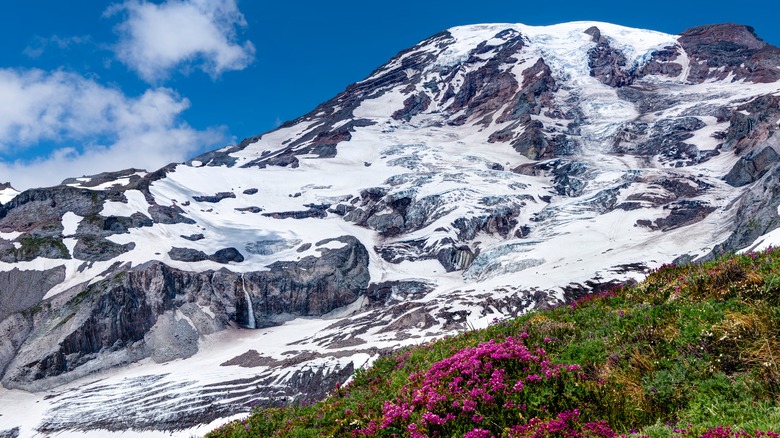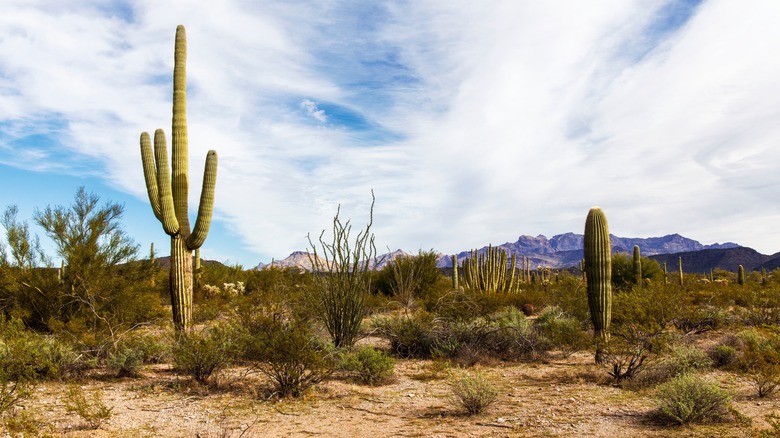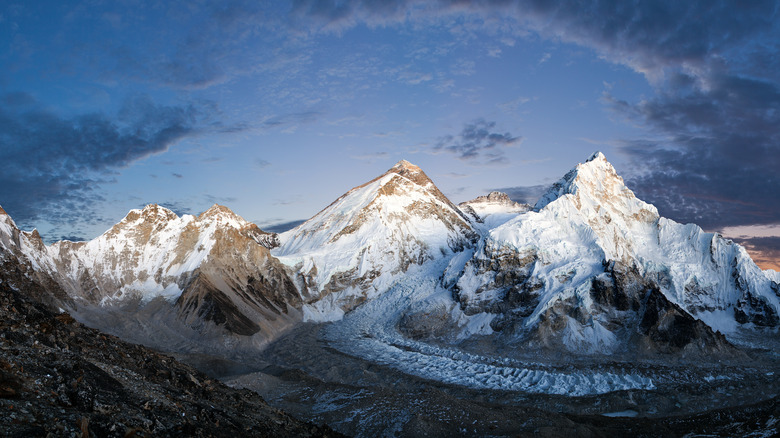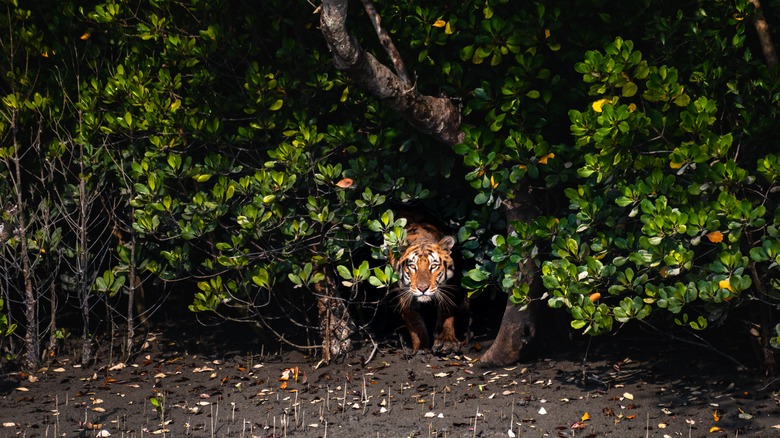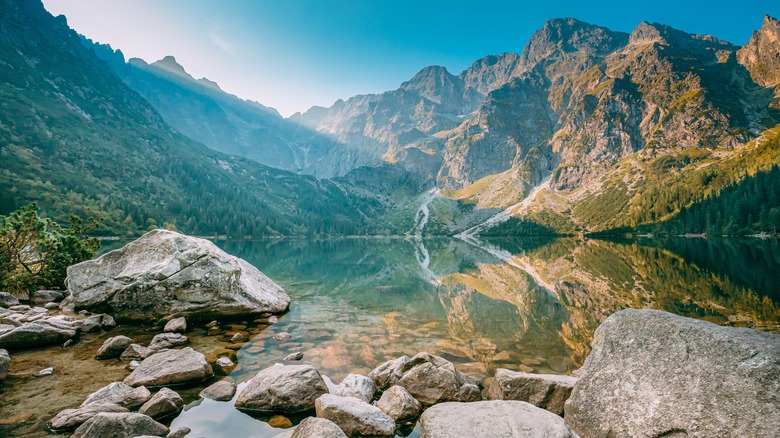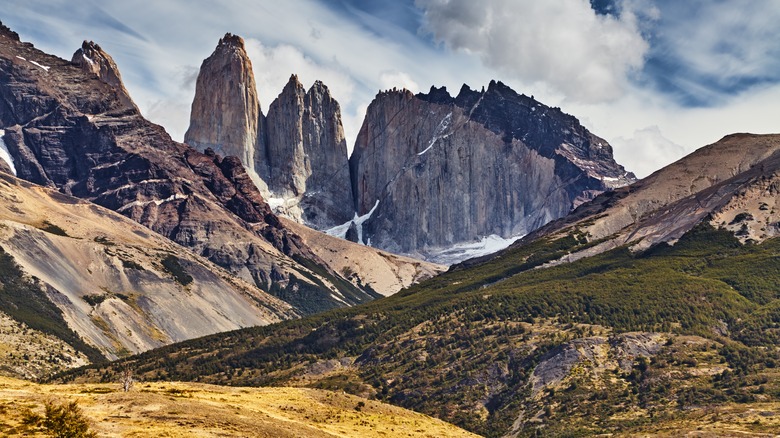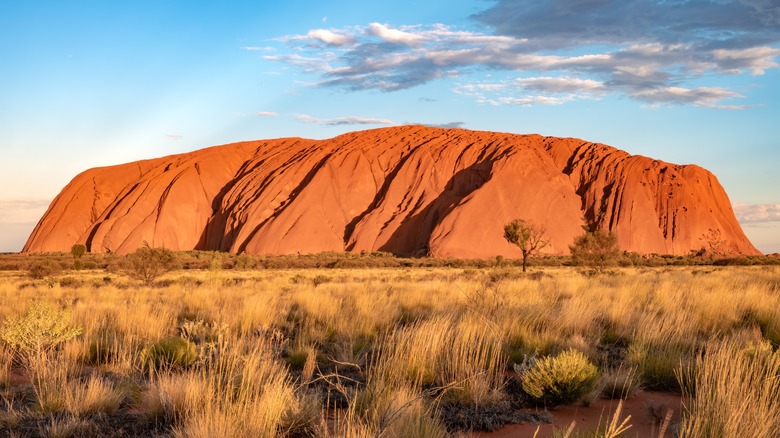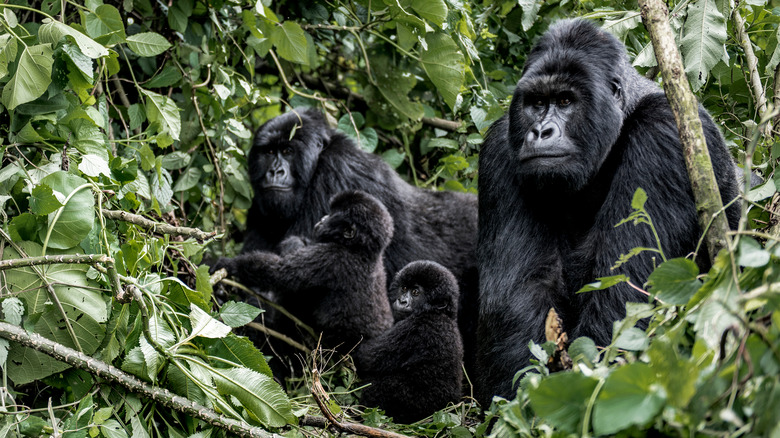You Should Think Twice Before Heading To The World's Most Dangerous Parks
Exploring the great outdoors can be such a rewarding experience. Not only does it provide excellent exercise, but it also exposes travelers to fresh air, expanses of flora and fauna, and new sights. Parks all over the world delight visitors, from waterfront wonders to mountainous marvels. Part of a park's appeal stems from how it connects people to nature, land, and water. And no two parks are the same. Some are carefully maintained and meticulously ordered, others are gloriously wild and free, presenting nature as close to its original form as possible.
Dedication to the preservation of wild spaces can come with danger. Some threats result from the land and its conditions, others from animals living within a park, but all pose genuine threats to visitors. While these aren't reasons to avoid the parks listed altogether, and the hazards won't affect every tourist, they are certainly concerns that should make travelers think carefully before planning a trip to these places.
Darién National Park - Panamá
An area in southern Panamá, Darién National Park is part of the Darién Gap, a vast area of jungles, forests, and wetlands that separates the northern and southern legs of the Pan-American Highway. The Darién Gap extends into Colombia (home of the secret island of Providencia) and is a forbidding place, with no roads or easy way to traverse it. These features have helped make the whole region, including this national park in Panamá, a haven for migrant smugglers, who work their way up through Central America to the U.S. border.
Not only is the terrain inhospitable, with muddy rivers and high mountain ranges among the obstacles, but crime is rife around Darién National Park. As if that weren't enough, the park has limited infrastructure, no cellphone service, and resident wildlife can pose a threat. Among the animal inhabitants are the jaguar and the harpy eagle, which has fearsome talons. Birdwatching is spectacular, though, with a wide variety of macaws living there.
Death Valley National Park - California, U.S.A.
In a sense, the name Death Valley says it all. Stretching across an expanse of the Sunshine State, northeast of Los Angeles and close to the border with Nevada, this park is the hottest place on the planet. Temperatures have surpassed 134F; in summer, the mercury can consistently climb over 120F, even in the shade. Death Valley is also the driest place on Earth, with annual rainfall not even reaching a couple of inches.
During late summer, when thunderstorms are most likely to unleash their fury, the baked terrain doesn't soak up water, and flash floods can occur in canyons. At other times of the year, when a cold front approaches, dust storms can cloud the atmosphere. For visitors, the heat can prove quietly and effortlessly debilitating. Travelers need to drink more than 1 gallon of water daily and avoid hiking in the lower elevations during the hottest part of the day. Dangerous animals in Death Valley include scorpions, deadly black-widow spiders, and rattlesnakes.
Gates of the Arctic National Park & Preserve - Alaska, U.S.A.
Gates of the Arctic is not a national park that's great for a family outing. It gets very few visitors, mainly because of its remote location — it's in the northern half of Alaska, many miles away from Fairbanks and Anchorage. Only a little over 11,000 visitors came there in 2023 (via NPS), where they encountered wilderness in its purest form. The park is rugged, with no formal trails or roads, huge valleys shaped by millennia of glacial activity, and raging rivers visited by grizzly bears.
Some bears in Gates of the Arctic have become accustomed to people, but this can sow a false sense of safety in travelers — these mammals are still wild animals, unpredictable, and best avoided. While trekking can be rewarding, only experienced hikers should enter this national park. The vegetation can be hard going, and some parts of the land are wet and sticky, with rivers coursing throughout the area. The National Parks Service suggests that hikers always have alternate routes in mind since the conditions can quickly change due to bad weather, wildfire smoke, and more.
Grand Canyon National Park - Arizona, U.S.A.
Grand Canyon National Park, a once-in-a-lifetime vacation destination, isn't Arizona's most deadly piece of nature. Lake Mead National Recreation, which spreads across Arizona and Nevada, experienced 56 drownings between 2013 and 2023, most of them in the summer, and more than 200 deaths overall in that period. Some of those were suicides, not caused by the park's inherent dangers, though the cold water in the lake does catch some swimmers unaware. At the Grand Canyon, where more than 130 people have perished in the last decade or so, the number of deaths might be lower, but the perils are much more varied.
In the summer, the Grand Canyon experiences extreme heat and chances of lightning, rock falls, and sudden, devastatingly powerful floods after a deluge. The warm, shallow pools of water around the park sometimes carry a parasite that can cause extreme skin itchiness. Certain algae are also toxic to visitors. Additionally, Gila monsters, scorpions, and rattlesnakes live throughout the Grand Canyon, and while they generally mind their own business, they are quite poisonous.
Gunung Merapi National Park - Indonesia
Mount Merapi is located in Gunung Merapi National Park, north of Yogyakarta, on the island of Java. It's the most active volcano in Indonesia, which is quite an achievement given that the Southeast Asian nation has 130 active volcanoes. Mount Merapi has become part of a well-worn tourism circuit that also includes the shrines of Borobudur and Prambanan, both Unesco World Heritage sites.
During a visit to the national park, which has a couple of entrances teeming with food stalls, visitors can find hiking trails and caves where Japanese soldiers hid during World War II. They'll also see sections of forest that were singed and charred by old lava flows, especially following the massive eruption in 2010. And lest travelers think that a past eruption means another one won't be forthcoming for a while, think again. The volcano spewed lava in late April 2024, with flows descending more than 1 mile down Merapi's slopes.
Hawaii Volcanoes National Park - Hawaii, U.S.A.
Volcanic architecture is the lure of Hawaii Volcanoes National Park on the Big Island. The geology and geography of this part of the U.S. draw many admirers, and the variety of landscapes is vast. The national park climbs all the way from the sea to almost 14,000 feet and is home to two of the most active volcanoes in the world — Kilauea and Mauna Loa. But with that dazzling range and rugged terrain comes an array of dangers. Visitors can experience rapid and extreme changes in temperature depending on their elevation.
The top of Kilauea is cold and crisp, even in the height of summer. Around Hawaii Volcanoes National Park are cracks in the land and cliffs with sheer drops. Winds pick up on the coast, making hiking along cliffs especially perilous and churning up the waves with strong surf. Since the volcanic landscape is always in flux, areas can be unstable, either slippery or on the precipice of collapse. Gases that rise from steam vents or the craters of the volcanoes can cause respiratory issues to some visitors.
Kafue National Park - Zambia
Situated in the western part of Zambia, Kafue National Park is huge. It is the nation's biggest national park and covers 8,000 square miles of southern Africa. It's also the oldest national park in the country, officially designated in the 1950s. Visitors come there not to be wowed by the vast numbers of wildlife but by the variety and range of the sights on offer.
Travelers can expect to encounter many antelopes, including red lechwe, yellow-backed duikers, and even a leopard (most likely on night drives). There are also cheetahs, wild dogs, crocodiles, and hippos in Kafue National Park. Bird life is abundant, from egrets, storks, and pelicans to wattled cranes. For some, the highlight is an elephant sighting, but there's the rub. In 2024, an American tourist died when an elephant charged the vehicle she was in while out on a safari. The bull elephant rolled over the safari jeep, an attack that seemed utterly unprovoked.
Madidi National Park - Bolivia
Due north of the administrative capital, La Paz, and not far from the border with Peru, Madidi National Park is massive. It's also very wild and home to a grand array of mammals, birds, fish, reptiles, and plants. Getting there requires considerable effort, and places to stay are far from the nearest town. There's no internet or cell phone signal, and visitors can quickly feel disconnected from daily life. For some travelers, this is the main reason for entering the park. The diversity of life is also appealing, and one estimate posits that one-tenth of all bird species on the planet can be found there.
And yet, some of the wildlife in Madidi National Park is deadly, from prowling pumas and poison dart frogs to merciless fire ants. Beyond that, adventurers will likely encounter poisonous plants, though they might need a guide to point them out. The park also has incredibly varied terrain, changing from humid, dense rainforest to the chilled slopes of the Bolivian Andes. This combination makes getting around can be pretty challenging.
Mount Rainier National Park - Washington, U.S.A.
Mount Rainier National Park in Washington's southwest has much to praise. It became the fifth national park in the U.S. in 1899. At the heart of the park, you'll find Mount Rainier, which tops out at more than 14,000 feet above sea level and has 25 glaciers. The area features about 260 miles of trails that hikers can explore and look for a wide range of birds, mammals, and plants. But Mount Rainier also has a harsh side.
Some parts of Mount Rainier National Park receive more than 50 feet of snowfall yearly. Scientists theorize that the volcanic mountain is the most volatile in the region, and an eruption would have devastating effects. Glacial melts caused by flowing lava would result in huge landslides. Because of the height of the mountain, those lahars, as they are known, would resemble giant rivers of concrete streaming down the slopes. The destruction in the valleys below could be immense.
Organ Pipe National Monument - Arizona, U.S.A.
Unraveling across the Sonoran Desert in the south of Arizona, this slice of nature is a study of life in arid, spare terrain. Organ Pipe National Monument has craggy hills, scrubby vegetation, and sharp, spindly cacti. Visitors can enjoy the scenery on a leisurely drive, follow a trail through the landscape, or camp under clear skies to watch a night filled with stars. Organ Pipe can also be unforgiving. The heat is sometimes brutal, often breaking 100F in the summer, while temperatures dip below freezing in the winter. Hydration, proper nutrition, and avoiding the hottest part of the day are essential.
There is dirt, gravel, or sand on many roads in Organ Pipe National Monument, and visitors with the wrong vehicle can get stuck. You can also get stuck by something sharp and pointy — the needle of a cactus, a plant found all over the park. Mountain lions are capable of causing much more harm than cactus, though sightings are infrequent. Perhaps more likely is the chance of seeing coyotes of the human sort. Part of Organ Pipe forms the U.S.-Mexico border, and smugglers will bring migrants through the park in search of a new beginning.
Sagarmatha National Park - Nepal
The name Sagarmatha National Park refers to the Nepalese moniker for Mt. Everest. Sagarmatha, which translates to "Goddess of the Sky," is the gateway to mountain expeditions from the Nepal side of the world's highest peak. Mt. Everest is full of interesting facts that many travelers might not know. The most obvious danger is related to climbing at such a high altitude, where the oxygen is thinner, and the temperatures can reach extreme lows. Hundreds of people have died in this park, and bodies often get left there since the logistics of bringing them down make it impractical. In 2023, 17 climbers perished while trying to conquer Everest.
The likelihood of glacial lake floods is rising in Sagarmatha National Park and the surrounding area, which would be catastrophic. Beyond the physical alpine risks, this altitude has a contaminated water supply, creating a health risk of a different sort. Samples from community drinking sources at villages and glacial melt in the park found high levels of E. coli, suggesting fecal contamination in the water.
Sundarbans National Park - Bangladesh and India
Sundarbans National Park, a Unesco World Heritage site, straddles Bangladesh and India. It is home to the biggest mangrove forests on the planet, a realm of deltas and swamps where the Ganges and Brahmaputra rivers empty into the Bay of Bengal. Visitors will discover a patchwork of dry terrain and wetland, with creeks, rivers, channels, estuaries, and canals all around.
Snakes and crocodiles live in the water, adding danger to any excursion, but the population of wild tigers is more remarkable. The giant cats have adapted to the aquatic aspect of the landscape and have learned to swim for prey, catching fish, crabs, and even large monitor lizards. The tigers are also responsible for the death of many villagers in the delta. While tiger sightings are rare, poachers are known to roam the forest, hoping to take down one of the creatures. In recent years, demand for tiger bones from Southeast and East Asian countries has soared. Encounter a poacher on a mission to make some money, and there's no predicting what might happen.
Tatra National Park - Poland
In the south of Poland by Slovakia, Tatra National Park has a sister park with the same name just over the border. It's a region of sharp, finely chiseled peaks with jagged points and harsh, unforgiving outlines. You'll find the highest mountain in Poland, Rysy, which rises to more than 8,000 feet above sea level. Visitors will uncover hundreds of caves, high waterfalls, and grand lakes elsewhere. However, conditions are prone to suddenly changing in these mountains, and the unpredictable weather has led to fatalities in Tatra National Park every year.
Winds, temperature, and the sun's relentless rays seem more potent in the mountains. One type of wind, called Halny, is especially dangerous and powerful. It sometimes brings with it foggy conditions that can disorient hikers. Avalanches are another threat, with hundreds of people buried under snow in the past 120 years. Lightning storms are also fatal, with one in 2019 killing five visitors and injuring more than 150 people.
Torres del Paine National Park - Chile
Located in the southern part of Chile, in a region called Patagonia, Torres del Paine National Park is an untamed wilderness. Unfortunately, the remoteness and difficulty of access that makes this a desirable escape also mean rescue services have a tough time getting in if things go wrong. The truth is that, as Elvis Costello sang so moodily, accidents will happen.
It doesn't help that the variable weather can flip with little warning, and the winds are strong enough to knock over hikers. In early 2024, an Irish trekker fell over 40 feet off a trail when swiped by a strong wind. The fall caused damage to his skull, and a severe loss of blood, and mountain rescue had to navigate tricky terrain when carrying him out on a stretcher. The incident was just one of a series of rescues in the first two months of 2024, and deaths occur in the park, usually due to falls.
Uluru-Kata Tjuta National Park - Australia
A natural icon in the heart of Australia, Uluru, also known as Ayers Rock, is sacred to local Aboriginal tribes. The giant red monolith within Uluru-Kata Tjuta National Park and the nearby Kata-Tjuta rock are believed to be the resting place of spirits. It's an impressive piece of geology, soaring up more than 1,000 feet from the surrounding desert as though it erupted out of nowhere. It's also big, more than 2 miles long, and almost as wide, forming a vaguely oval shape.
Colored a deep red, thanks to its sandstone composition, Uluru glows like fire at sunset when warmed by the sun's waning rays. Desert extends in all directions around this mammoth monolith, and the long, seemingly never-ending plains can get blisteringly hot. Summer temperatures, which occur during winter in the U.S. (December-March), frequently top 100F, and dehydration and heat stroke are serious dangers for visitors. The park is also home to wild dingos, dogs with teeth that can do some real damage, and the venomous king brown snake.
Virunga National Park - Democratic Republic of Congo
For many adventurers, seeing wild mountain gorillas in Africa is on their travel bucket list. It's the star attraction at Virunga National Park, a large protected reserve also home to the eastern chimpanzee and the eastern lowland gorilla. Mountain gorillas only live in a small part of the continent, and about one-third have settled in Virunga. Mountain gorillas are pregnant for 9 months before giving birth, and the babies weigh only a few pounds. When they reach full size, male adults can weigh more than 400 pounds and stand up 5 feet tall.
Even in this area gazetted as a preserve, their existence is threatened. Poachers and militias are active in Virunga, the former set on killing gorillas; the latter caught up in a war between groups funded by Congo and neighboring Rwanda. Unfortunately, park rangers, and sometimes civilians, are accidentally mired in trouble. Armed militia killed three park rangers and a technician in May 2023, proof of the great danger at Virunga.
